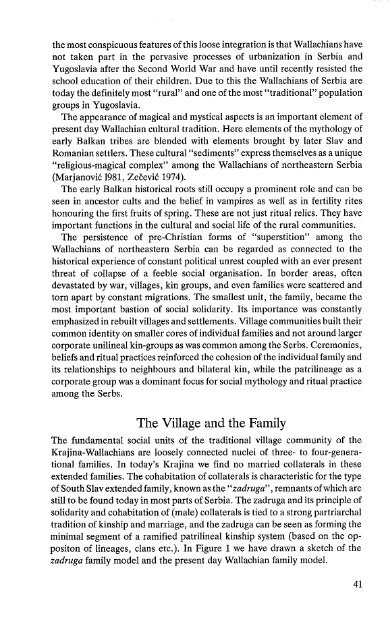Will they still be dancing? (1982)
Etnographic study of Romanians from East Serbia in Sweden in 1980s
Etnographic study of Romanians from East Serbia in Sweden in 1980s
You also want an ePaper? Increase the reach of your titles
YUMPU automatically turns print PDFs into web optimized ePapers that Google loves.
the most conspicuous features of this loose integration is that Wallachians have<br />
not taken part in the pervasive processes of urbanization in Serbia and<br />
Yugoslavia after the Second World War and have until recently resisted the<br />
school education of their children. Due to this the Wallachians of Serbia are<br />
today the definitely most "rural" and one ofthe most "traditional" population<br />
groups in Yugoslavia.<br />
The appearance ofmagical and mystical aspects is an important element of<br />
present day Wallachian cultural tradition. Here elements of the mythology of<br />
early Balkan tri<strong>be</strong>s are blended with elements brought by later Slav and<br />
Romanian settlers. These cultural "sediments" express themselves as a unique<br />
"religious-magical complex" among the Wallachians of northeastern Serbia<br />
(Marjanovic 1981, Zecevic 1974).<br />
The early Balkan historical roots <strong>still</strong> occupy a prominent role and can <strong>be</strong><br />
seen in ancestor cults and the <strong>be</strong>lief in vampires as well as in fertility rites<br />
honouring the first fruits of spring. These are not just ritual relics. They have<br />
important functions in the cultural and social life of the rural communities.<br />
The persistence of pre-Christian forms of "superstition" among the<br />
Wallachians of northeastern Serbia can <strong>be</strong> regarded as connected to the<br />
historical experience of constant political unrest coupled with an ever present<br />
threat of collapse of a feeble social organisation. In border areas, often<br />
devastated by war, villages, kin groups, and even families were scattered and<br />
torn apart by constant migrations. The smallest unit, the family, <strong>be</strong>came the<br />
most important bastion of social solidarity. Its importance was constantly<br />
emphasized in rebuilt villages and settlements. Village communities built their<br />
common identity on smaller cores of individual families and not around larger<br />
corporate unilineal kin-groups as was common among the Serbs. Ceremonies,<br />
<strong>be</strong>liefs and ritual practices reinforced the cohesion ofthe individual family and<br />
its relationships to neighbours and bilateral kin, while the patrilineage as a<br />
corporate group was a dominant focus for social mythology and ritual practice<br />
among the Serbs.<br />
The Village and the Family<br />
The fundamental social units of the traditional village community of the<br />
Krajina-Wallachians are loosely connected nuclei of three- to four-generational<br />
families. In today's Krajina we find no married collaterals in these<br />
extended families. The cohabitation of collaterals is characteristic for the type<br />
of South Slav extended family, known as the "zadruga", remnants ofwhich are<br />
<strong>still</strong> to <strong>be</strong> found today in most parts of Serbia. The zadruga and its principle of<br />
solidarity and cohabitation of (male) collaterals is tied to a strong partriarchal<br />
tradition of kinship and marriage, and the zadruga can <strong>be</strong> seen as forming the<br />
minimal segment of a ramified patrilineal kinship system (based on the oppositon<br />
of lineages, clans etc.). In Figure 1 we have drawn a sketch of the<br />
zadruga family model and the present day Wallachian family model.<br />
41
















